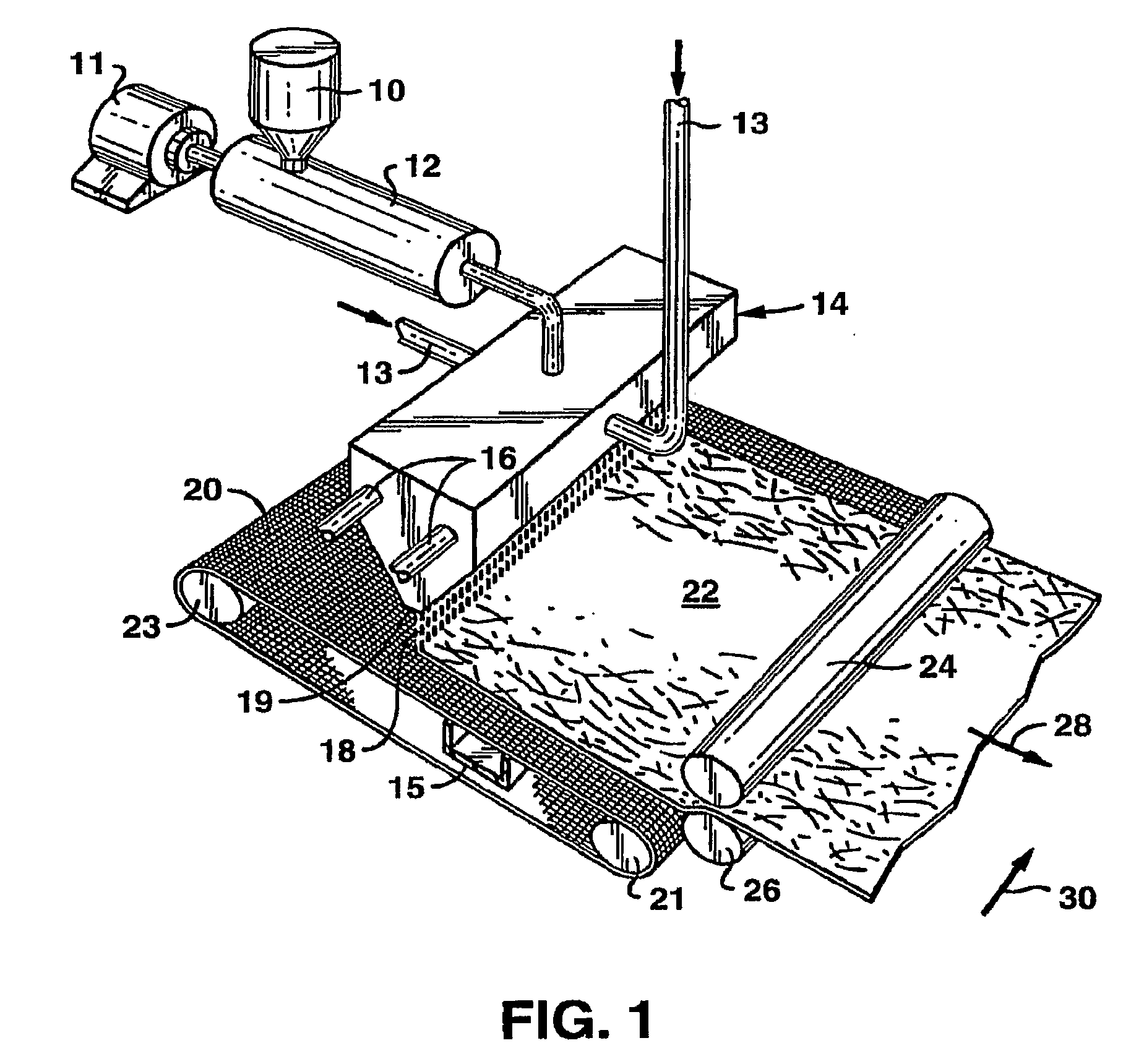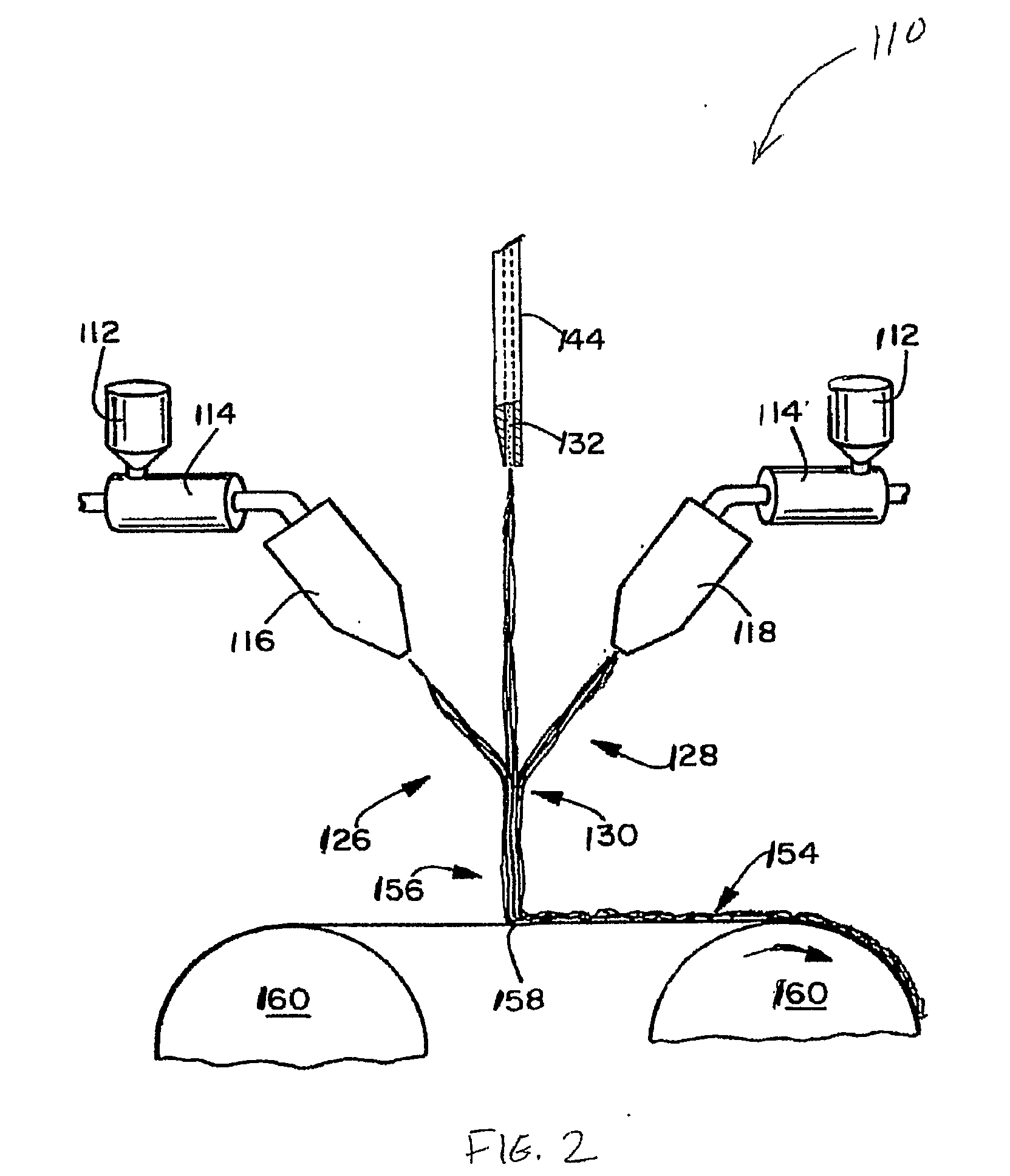Biodegradable polyesters for use in forming fibers
a technology of biodegradable polyesters and fibers, which is applied in the direction of weaving, synthetic resin layered products, chemistry apparatus and processes, etc., can solve the problem that conventional aliphatic polyesters are not typically suitable for meltblowing
- Summary
- Abstract
- Description
- Claims
- Application Information
AI Technical Summary
Problems solved by technology
Method used
Image
Examples
example 1
[0107]Two grades of polyesters were employed, i.e., Ecoflex® FBX7011 supplied by BASF and Enpol™ G4560J supplied by Ire Chemical, Korea. Resins were formed as described below in Table 1 and melt processed using a Wernerer Phleiderer Model ZSK-30 twin screw extruder (L / D ratio of 44). A high shear screw setting was employed that included a total of 19 low shear conveying elements and a total of 39 high shear kneading elements. After extrusion, the modified polymer strands were cooled on a conveyor belt and pelletized. Resins were used both dry and pre-moisturized. Moisture content was measured prior to extrusion and resin was extruded using the melt processing conditions illustrated in Tables 2-3. Final moisture content and final melt flow rate (MFR) were measured after pelletization of the modified resin.
TABLE 1Resin ContentAdditiveInitial Moisture levelSamplePolymer(wt. %)(ppm)1Enpol G4560J—4842Enpol G4560J—4843Enpol G4560J—4844Enpol G4560J—4845Enpol G4560JPEG 8000484(10 wt. %)6Eco...
example 2
[0109]Sample 12 of Example 1 was tested to determined the effect of drying on the final melt flow rate (MFR). The drying conditions and test results are set forth below in Table 4.
TABLE 4Properties of Dried ResinFinalFinal MoistureMFR,DryingContent190° C.% MFRSamplePolymerconditions(ppm)(g / 10 min)Reduction12Ecoflex—145131—FBX7011140° F.,102303.2348 hours
[0110]As indicated, some reduction in melt flow rate was indicated after drying.
example 3
[0111]Several of the resins of Example 1 were tested to determine their molecular weight. The results are shown in below in Table 5.
TABLE 5Molecular WeightPoly.Sample No.MwzMwwMwnIndex1201400135100848001.592163800114400712001.613155100107100649001.654144000100900630001.60514520095400570001.67
[0112]As indicated, modification of the resin resulted in a significant reduction in number average molecular weight (Mwn′), weight average molecular weight (Mww), and z-average molecular weight (Mwz). For instance, the number average molecular weight of Sample No. 4 was reduced to 63,000 from 84,000 and the weight average molecular weight was reduced to 100,900 from 135,100.
PUM
| Property | Measurement | Unit |
|---|---|---|
| Temperature | aaaaa | aaaaa |
| Temperature | aaaaa | aaaaa |
| Temperature | aaaaa | aaaaa |
Abstract
Description
Claims
Application Information
 Login to View More
Login to View More - R&D
- Intellectual Property
- Life Sciences
- Materials
- Tech Scout
- Unparalleled Data Quality
- Higher Quality Content
- 60% Fewer Hallucinations
Browse by: Latest US Patents, China's latest patents, Technical Efficacy Thesaurus, Application Domain, Technology Topic, Popular Technical Reports.
© 2025 PatSnap. All rights reserved.Legal|Privacy policy|Modern Slavery Act Transparency Statement|Sitemap|About US| Contact US: help@patsnap.com



